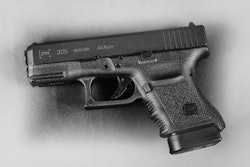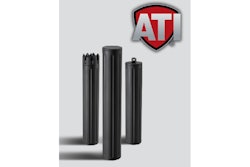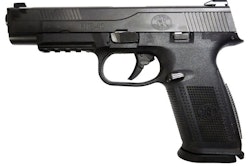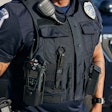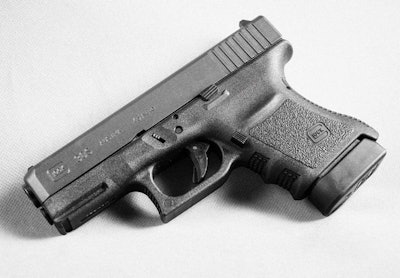 Photo by Mark W. Clark.
Photo by Mark W. Clark.
Most people wouldn't put Glock in the category of firearms manufacturers known for their wide variety and constant stream of new products. Glock will make you any kind of pistol you want, as long as it is a polymer-framed, striker-fired semi-automatic, in black. I'm not saying Glock is boring, the company just sticks to what it does best. I admire this in any firearms manufacturer; especially one that has, in my humble opinion, perfected the combat pistol.
First Impressions
So when I walked up to the Glock table at the 2013 SHOT Industry Day to speak with the company's reps, I wasn't expecting to see anything that would blow my mind, but I was curious what they had in the line-up for the new year.
The Glock representative answered my question by handing me the new 30S pistol. I have to say I raised an eyebrow.
Now it took me a few questions and a little close examination to figure out exactly what the Glock 30S was. It was a Glock, that much was obvious. It was in .45 ACP, and it was on the smaller side. But I couldn't squarely place it in the usual hierarchy of Glock sizes.
Glock has always made a standard, a compact, and a subcompact in almost every caliber it produces. The 30S was a hybrid of a few of these. The Glock rep must've seen this reaction more than a few times that morning because he quickly stepped in to bring an end to my head scratching. He broke it down for me this way.
The frame is borrowed from the 30SF; a subcompact .45 ACP with a capacity of 10 rounds. The benefit here is a larger frame allowing for 10-round capacity. The 30SF backstrap was reduced slightly to allow for shooters with smaller hands. The drawback was the size of the slide, which remained unchanged and very broad. The slide for the 30S was borrowed from the 36; one of the Glock "Slimline" pistols. The 36 is a great pistol that incorporates .45 ACP power in a slim and easily concealable package. Its biggest downfall is its capacity at only six rounds.
Glock recognized the strengths and weaknesses of each of these guns and combined the best (frame from a 30SF and slide from a 36) to create the 30S; an easy to shoot, comfortable in the hand, highly concealable .45 that holds 10 rounds. Does it fill a need? I would say so.
As we were talking, I was loading magazines in preparation to shoot this new little wonder. Once I had wrapped my head around what the 30S was, it was time for me to see if Glock's latest offering could perform. Let me preface this by giving you a little of my .45 ACP background. I primarily shoot a Glock in the .40 S&W cartridge. It is what I was issued when I became an officer almost a decade ago.
Anyone who has shot one will tell you the .40 is a violent, albeit well-performing little round. The .45 ACP is bigger but in my opinion produces surprisingly little felt recoil compared to the .40 S&W. I first experienced this when I purchased my first 1911 and my opinion hasn't changed after firing countless other .45s. So that was never a complaint of mine when shooting Glock's variety of .45 ACP pistols. My only real complaint was their size. I consider myself someone who has big hands and the .45s are too big for my taste.
Holding the 30S in my hand as I got comfortable with the dimensions and fine-tuned my firing grip I immediately noticed the difference. My secondary pistol is a Glock 23; a .40 compact. With the 30S' extended magazine baseplate and the slimmer slide my grip felt surprisingly similar. So if you've been yearning for a Glock 23 that fires 10 rounds of .45 ACP, this might be the answer to your prayers.
After fondling the 30S for probably far too long I charged up a fresh magazine and started popping rounds into the berm. As I suspected, the felt recoil was very pleasant and follow-up shots were almost easy. The dimensions of the 30S felt fantastic in my hand, and I quickly decided I could be happy with one of these concealed in my waistband.
After cycling through three magazines, I thanked the Glock reps and continued on with my day. I did, however, make a note to see this 30S again in the near future.
Out of the Box
My test sample 30S arrived a few months later, and I picked up right where I had left off at the SHOT Show. The 30S is textured in the Glock "Gen 3" configuration. I am a fan of the new "Gen 4" texture and would hope that is on the list of future 30S upgrades.
The 30S has a rail section forward of the trigger guard for mounting a light and the standard Glock polymer sights. I actually like Glock's standard sights. My only complaint would be their lack of night visibility. Glock offers a few others, including factory night sights for those of you who prefer something else.
And the trigger? Glock's standard coiled trigger spring gives the 30S a crisp brake at about 5.5 pounds, the same as almost every Glock rolling off the assembly line.
Punching Paper
I had no doubt about the reliability of this gun; it's a Glock. I also had no unanswered questions about the grip or feel of the gun when firing. I had checked these off at SHOT and was impressed with both. I was a little curious about accuracy though so I picked up a variety of .45 ACP and hit the range to see what the 30S could do.
Let's set some ground rules before we go down this road. My testing is anything but scientific. I picked the ammo because it was the best variety of practice and duty grade rounds on hand at my local sporting goods store, not because there is some distinct difference between them. And I chose my "methods" based solely on how I felt like shooting that day, not to produce data I could put on a chart.
Generally, I don't think most cops care too much about the ballistic stats of a gun. We want to know if the gun can perform in a deadly force encounter, function reliably, and hit what we intend it to.
My four ammo choices were: Remington Golden Sabre 185-grain Brass Jacketed Hollow Point, Winchester 230-grain Full-Metal Jacket Practice Rounds, Federal Premium Hydra-Shok 165-gr Low-Recoil Jacketed Hollow Point, and Hornady Zombie Max 185-grain Z-MAX. (I couldn't resist that Zombie ammo, but I don't recommend you carry it in any duty or self-defense gun. It could be a problem in court.)
I set my target at 15 yards. This is what I would consider the high average distance of most police shootings and where accuracy would be paramount. I shot five five-round groups, unsupported, with no time limit. I then shot the same groups from a supported position, similar to lying prone over the hood of a patrol vehicle. At the end I mixed up the variety of rounds and shot them at a rapid pace to check cycling reliability. As I suspected there were no issues here.
Checking my groups I was able to keep almost all of them under two inches, with the occasional flyer here and there, which I attribute to the monkey, not the machine. Considering the 30S is a subcompact designed primarily as a back-up combat weapon and not a competition gun, I was pretty impressed. Glock's barrels have always been known for their accuracy and this was no exception.
My next test was to put the 30S to work as it was intended, as a concealed back-up gun. I have a simple Kydex holster that rides inside my waistband and the 30S was able to snap into it nicely. I carried it around for a few days in this configuration and was pleasantly surprised at how manageable it was. My usual concealed-carry pistol is a subcompact and very slim 9mm so the 30S was a big step up in size. After a couple of days of having it follow me to the grocery store, post office, and gym, I was convinced this was a gun I could see myself carrying all the time. A .45 ACP that holds 10 rounds you can carry concealed all the time and not drive you crazy? Yeah, it surprised me, too.
The Big Questions
The Glock 30S comes from the factory with the standard Glock sights, a cleaning rod and brush, speed-loader and a couple of magazines packed neatly in a hard plastic case. If you throw down your LE credentials you can pick one up through Glock's "Blue Label" program for a steal.
So here are the real questions you have to answer before you decide the 30S is a gun for you. Do you carry a .45 ACP as a primary weapon and want the continuity with your secondary pistol? Or are you convinced the .45 ACP is the best round out there and wouldn't think of carrying anything else? If the answer to either is yes, you need to check out the new Glock 30S. All of the gripes I had about previous Glock .45s have been remedied with this one and I'm certain it'll be a winner.
A.J. George is an officer with the Scottsdale (Ariz.) Police Department currently assigned to the advanced training unit as a firearms and tactics instructor.
Glock 30S Subcompact Pistol Specs:
Caliber: .45 ACP
Capacity: 10 Rounds
Weight (empty): 20.28 Ounces
Width: 1.28 inches
Height: 4.8 inches
Overall Length: 6.97 inches
Barrel Length: 3.78 inches
Finish: Polymer with Tenifer Coated Slide
Trigger: Safe-Action, 5.5-pound pull
Sights: Fixed, standard Glock polymer Sights
Price: $598






